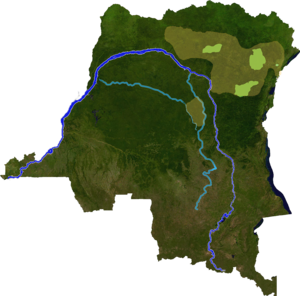Maiko National Park
|
Maiko National Park
|
|
|
Panorama of the southern Maiko National Park |
|
| location | Democratic Republic of Congo |
| surface | 10,830 km² |
| WDPA ID | 1080 |
| Geographical location | 0 ° 30 ′ S , 27 ° 30 ′ E |
| Setup date | 1970 |
| administration | Congolais Institute for the Conservation of Nature (ICCN) |
The Maiko National Park (also called Maiko National Park , French Parc National de la Maïko ) is located in the east of the Democratic Republic of the Congo in the provinces of Tshopo , Maniema and North Kivu between Lake Kiwu and the city of Kisangani at an altitude of 600 to 1300 m above sea level. It is 10,830 square kilometers, far from populated areas and almost exclusively covered by dense afromontane rainforest. With over 2000 mm of annual precipitation and a relative humidity of around 90 percent, Maiko National Park is one of the rainiest parks in Africa. The area has been under protection since 1938, the national park itself was established in 1970. Between it and the Kahuzi-Biéga National Park there are two smaller protected areas with a total size of 2300 square kilometers; six more were still being planned in 2007.
Wildlife
Here in the Democratic Republic of Congo living endemic eastern lowland gorillas (critically endangered, about 860 individuals in the park), okapi (high risk, estimated 2,500 animals), Congo peacock and Wasserzivetten , also mountain gorillas (an endangered species), Eastern Chimpanzee (high risk) and other primate species , Pinselohr- , Riesenwald- and bush pigs , African mouse deer , forest buffalo , leopard , Nile crocodiles , Prigogine owls , Sitatungas , bongos , Bates's pygmy antelope and six duiker , namely blue duiker , Weyns-Ducker , black-fronted duiker , bay duiker , white-bellied duiker and yellow-backed duiker . With its vegetation, water supply and inaccessibility, the Maiko National Park offers an ideal habitat for ( forest ) elephants, for example the seeds of the Gilbertiodendron forests are eaten by forest elephants and buffalo. A 2005 study found a total of 35 species of mammals living in the south of the park.
Human threat
The subsistence economy of the six million inhabitants of the Maiko- Tayna - Kahuzi-Biega area in the middle of the province of North Kivu includes shifting cultivation , hunting for bushmeat and herding of cattle, goats and sheep. Problems for Maiko National Park arise from fighting, the mining of natural resources and poaching. In July 2007, for example, a family of seven gorillas was killed by unknown poachers and left behind.
As early as 1964, Simba rebels had settled in the area of the national park. In the course of time there were repeated disputes, so that in 2010 the planning for a relocation of this community began.
literature
- Wally and Horst Hagen: The African national parks as habitats for elephants . In: Vitus B. Dröscher : Save the elephants of Africa . 1st edition. Goldmann Verlag , Munich 1992, ISBN 3-442-12322-4 . Pp. 250-251.
Web links
- Video Introducing Maiko National Park of the initiative The Forgotten parks of FZS
- Page to the Maïko National Park of the Berggorilla & Regenwald Direkthilfe eV
Individual evidence
- ↑ Report Eastern Lowland Gorilla Population Plummets 70 Percent Since 1994 from 2004 at Conservation International (English)
- ^ Announcement New Conservationists Graduate from Local University in Democratic Republic of Congo from 2007 at Conservation International (English)
- ↑ Rod East (Ed.): " Antelopes: Global Survey and Regional Action Plans. West and Central Africa "(English)
- ↑ Rod East (Ed.): " African Antelope Database 1998 " (English)
- ↑ Gorilla Journal No. 31 of December 2005 , page 5 (PDF file; 1.0 MB)
- ↑ brochure resilient by Conservation International (PDF, English)
- ↑ The Maiko-Tayna-Kahuzi-Biega landscape at Jane Goodall Institute (English)
- ↑ Article “Good prospects for Maiko” by Berggorilla & Regenwald Direkthilfe eV from September 2012
- ↑ Article “Resettlement of the Simba is imminent” by Berggorilla & Regenwald Direkthilfe eV from November 2012

